Hyundai Grandeur 2002 Owner's Manual
Manufacturer: HYUNDAI, Model Year: 2002, Model line: Grandeur, Model: Hyundai Grandeur 2002Pages: 230, PDF Size: 3.82 MB
Page 161 of 230
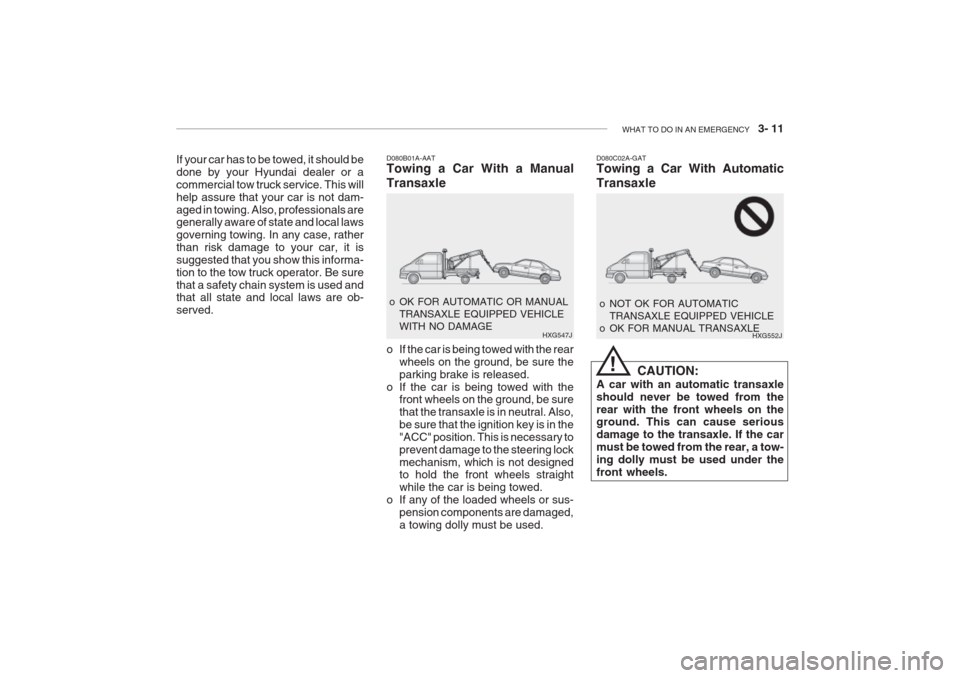
WHAT TO DO IN AN EMERGENCY 3- 11
D080C02A-GAT Towing a Car With Automatic Transaxle
CAUTION:
A car with an automatic transaxle should never be towed from therear with the front wheels on the ground. This can cause serious damage to the transaxle. If the carmust be towed from the rear, a tow-ing dolly must be used under thefront wheels.
o NOT OK FOR AUTOMATIC
TRANSAXLE EQUIPPED VEHICLE
o OK FOR MANUAL TRANSAXLE HXG552JD080B01A-AAT Towing a Car With a Manual Transaxle
o If the car is being towed with the rear
wheels on the ground, be sure the parking brake is released.
o If the car is being towed with the front wheels on the ground, be surethat the transaxle is in neutral. Also,be sure that the ignition key is in the"ACC" position. This is necessary toprevent damage to the steering lockmechanism, which is not designed to hold the front wheels straight while the car is being towed.
o If any of the loaded wheels or sus-
pension components are damaged,a towing dolly must be used.
o OK FOR AUTOMATIC OR MANUAL
TRANSAXLE EQUIPPED VEHICLE WITH NO DAMAGE HXG547J
If your car has to be towed, it should be done by your Hyundai dealer or acommercial tow truck service. This willhelp assure that your car is not dam-aged in towing. Also, professionals are generally aware of state and local laws governing towing. In any case, ratherthan risk damage to your car, it issuggested that you show this informa-tion to the tow truck operator. Be surethat a safety chain system is used and that all state and local laws are ob- served.
!
Page 162 of 230
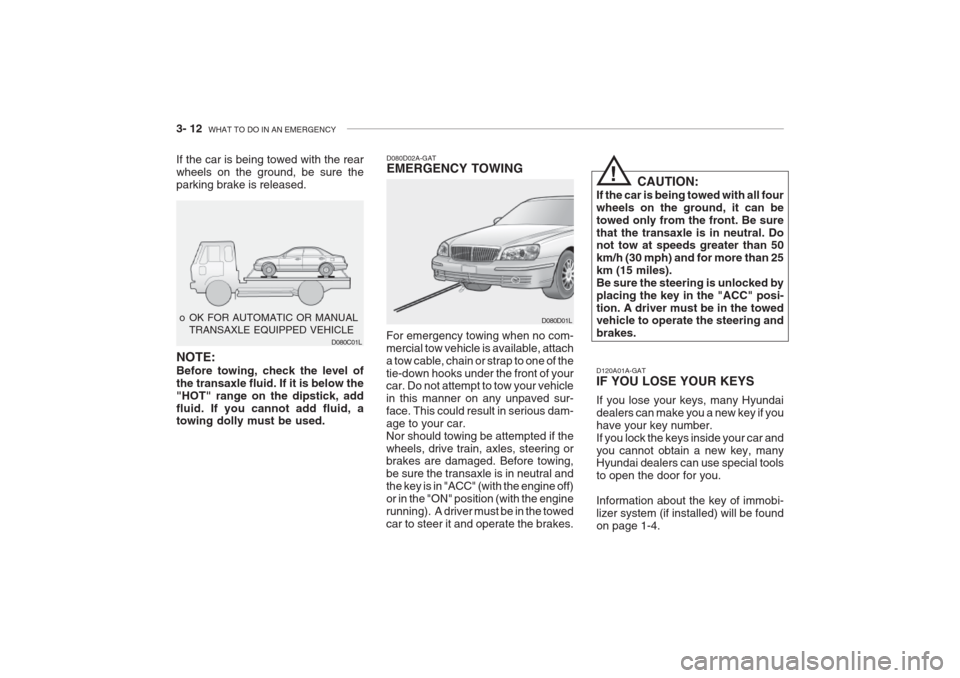
3- 12 WHAT TO DO IN AN EMERGENCY
If the car is being towed with the rear wheels on the ground, be sure theparking brake is released.
o OK FOR AUTOMATIC OR MANUAL
TRANSAXLE EQUIPPED VEHICLE D080C01LD080D02A-GAT EMERGENCY TOWING
For emergency towing when no com- mercial tow vehicle is available, attacha tow cable, chain or strap to one of thetie-down hooks under the front of your car. Do not attempt to tow your vehicle in this manner on any unpaved sur-face. This could result in serious dam-age to your car.Nor should towing be attempted if thewheels, drive train, axles, steering or brakes are damaged. Before towing, be sure the transaxle is in neutral andthe key is in "ACC" (with the engine off)or in the "ON" position (with the enginerunning). A driver must be in the towedcar to steer it and operate the brakes. D080D01L
CAUTION:
If the car is being towed with all fourwheels on the ground, it can betowed only from the front. Be surethat the transaxle is in neutral. Do not tow at speeds greater than 50 km/h (30 mph) and for more than 25km (15 miles).Be sure the steering is unlocked byplacing the key in the "ACC" posi-tion. A driver must be in the towed vehicle to operate the steering and brakes. D120A01A-GAT IF YOU LOSE YOUR KEYS If you lose your keys, many Hyundai dealers can make you a new key if youhave your key number.If you lock the keys inside your car andyou cannot obtain a new key, many Hyundai dealers can use special tools to open the door for you. Information about the key of immobi- lizer system (if installed) will be foundon page 1-4.
!
NOTE: Before towing, check the level of the transaxle fluid. If it is below the"HOT" range on the dipstick, addfluid. If you cannot add fluid, a towing dolly must be used.
Page 163 of 230
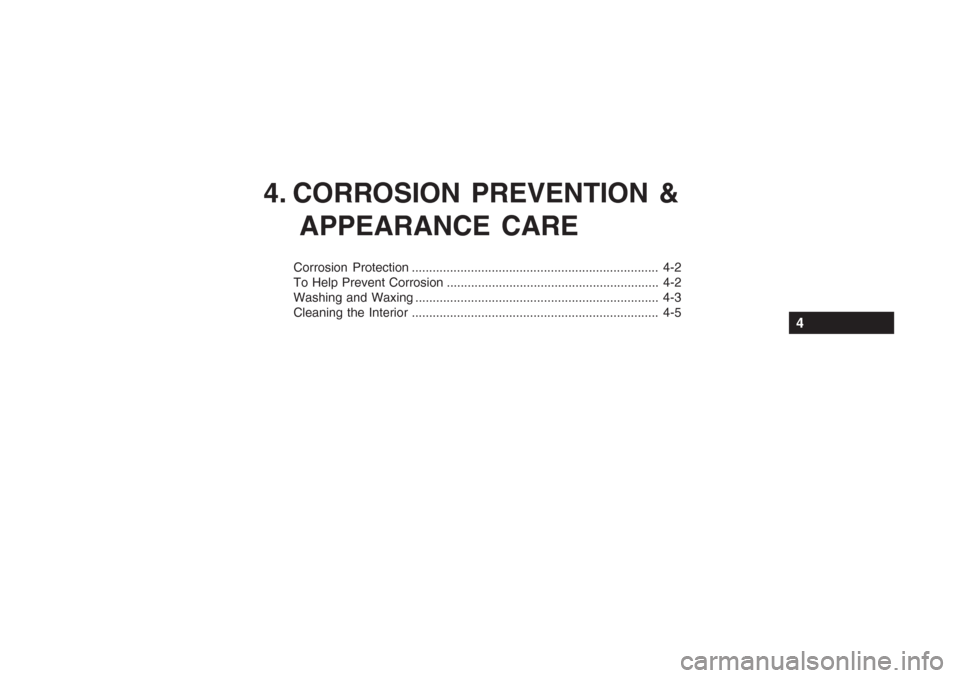
4. CORROSION PREVENTION &APPEARANCE CARE
Corrosion Protection ....................................................................... 4-2
To Help Prevent Corrosion ............................................................. 4-2
Washing and Waxing ...................................................................... 4-3
Cleaning the Interior ....................................................................... 4-5
4
Page 164 of 230
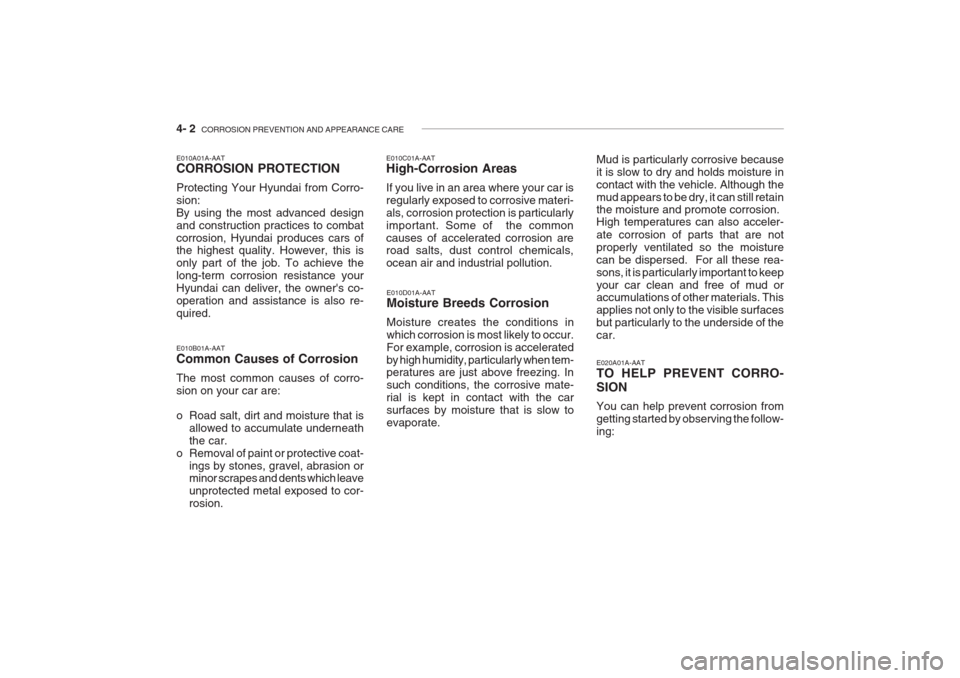
4- 2 CORROSION PREVENTION AND APPEARANCE CARE
E010A01A-AAT CORROSION PROTECTION Protecting Your Hyundai from Corro- sion:By using the most advanced designand construction practices to combatcorrosion, Hyundai produces cars of the highest quality. However, this is only part of the job. To achieve thelong-term corrosion resistance yourHyundai can deliver, the owner's co-operation and assistance is also re-quired. E010C01A-AAT High-Corrosion Areas If you live in an area where your car is regularly exposed to corrosive materi-als, corrosion protection is particularlyimportant. Some of the commoncauses of accelerated corrosion are road salts, dust control chemicals, ocean air and industrial pollution.
E010B01A-AAT Common Causes of Corrosion The most common causes of corro- sion on your car are:
o Road salt, dirt and moisture that is allowed to accumulate underneath the car.
o Removal of paint or protective coat-
ings by stones, gravel, abrasion or minor scrapes and dents which leave unprotected metal exposed to cor-rosion. E010D01A-AAT Moisture Breeds Corrosion Moisture creates the conditions in which corrosion is most likely to occur.For example, corrosion is acceleratedby high humidity, particularly when tem- peratures are just above freezing. In such conditions, the corrosive mate-rial is kept in contact with the carsurfaces by moisture that is slow toevaporate. Mud is particularly corrosive becauseit is slow to dry and holds moisture incontact with the vehicle. Although themud appears to be dry, it can still retainthe moisture and promote corrosion. High temperatures can also acceler- ate corrosion of parts that are notproperly ventilated so the moisturecan be dispersed. For all these rea-sons, it is particularly important to keepyour car clean and free of mud or accumulations of other materials. This applies not only to the visible surfacesbut particularly to the underside of thecar. E020A01A-AAT TO HELP PREVENT CORRO- SION You can help prevent corrosion from getting started by observing the follow-ing:
Page 165 of 230
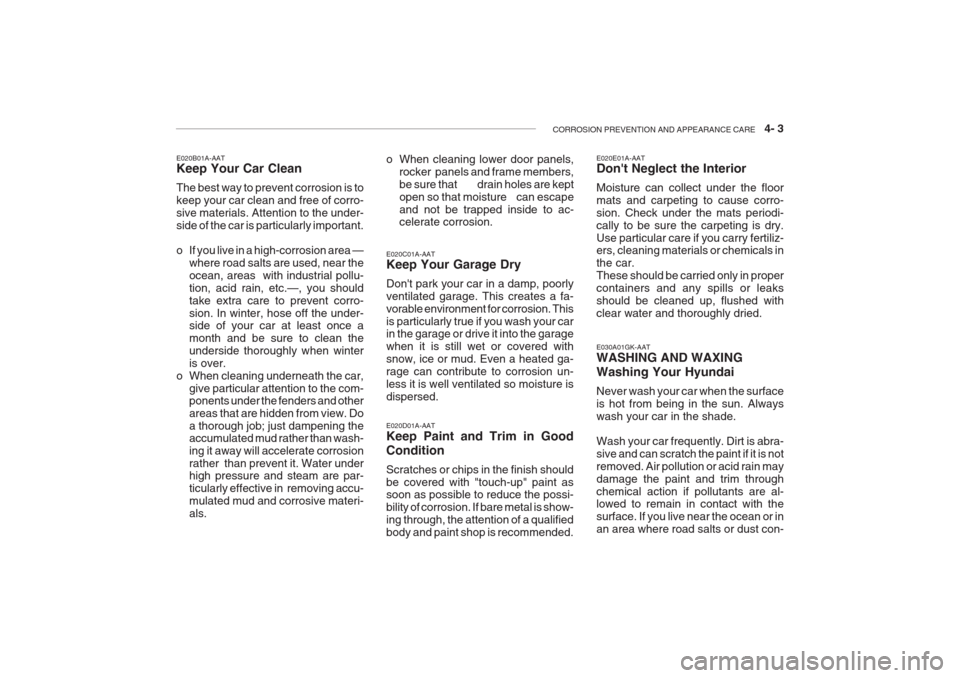
CORROSION PREVENTION AND APPEARANCE CARE 4- 3
E020C01A-AAT Keep Your Garage Dry Don't park your car in a damp, poorly ventilated garage. This creates a fa-vorable environment for corrosion. Thisis particularly true if you wash your car in the garage or drive it into the garage when it is still wet or covered withsnow, ice or mud. Even a heated ga-rage can contribute to corrosion un-less it is well ventilated so moisture isdispersed. E020D01A-AAT Keep Paint and Trim in Good Condition Scratches or chips in the finish should be covered with "touch-up" paint as soon as possible to reduce the possi- bility of corrosion. If bare metal is show-ing through, the attention of a qualifiedbody and paint shop is recommended. E020E01A-AAT Don't Neglect the Interior Moisture can collect under the floor mats and carpeting to cause corro-sion. Check under the mats periodi-cally to be sure the carpeting is dry.Use particular care if you carry fertiliz- ers, cleaning materials or chemicals in the car.These should be carried only in propercontainers and any spills or leaksshould be cleaned up, flushed withclear water and thoroughly dried.
E020B01A-AAT Keep Your Car Clean The best way to prevent corrosion is to keep your car clean and free of corro-sive materials. Attention to the under-side of the car is particularly important.
o If you live in a high-corrosion area —
where road salts are used, near the ocean, areas with industrial pollu-tion, acid rain, etc.—, you shouldtake extra care to prevent corro-sion. In winter, hose off the under- side of your car at least once a month and be sure to clean theunderside thoroughly when winteris over.
o When cleaning underneath the car,
give particular attention to the com- ponents under the fenders and other areas that are hidden from view. Doa thorough job; just dampening theaccumulated mud rather than wash-ing it away will accelerate corrosionrather than prevent it. Water under high pressure and steam are par- ticularly effective in removing accu-mulated mud and corrosive materi-als. o When cleaning lower door panels,
rocker panels and frame members,be sure that drain holes are keptopen so that moisture can escapeand not be trapped inside to ac- celerate corrosion.
E030A01GK-AATWASHING AND WAXING Washing Your Hyundai Never wash your car when the surface is hot from being in the sun. Alwayswash your car in the shade. Wash your car frequently. Dirt is abra- sive and can scratch the paint if it is notremoved. Air pollution or acid rain maydamage the paint and trim throughchemical action if pollutants are al- lowed to remain in contact with the surface. If you live near the ocean or inan area where road salts or dust con-
Page 166 of 230
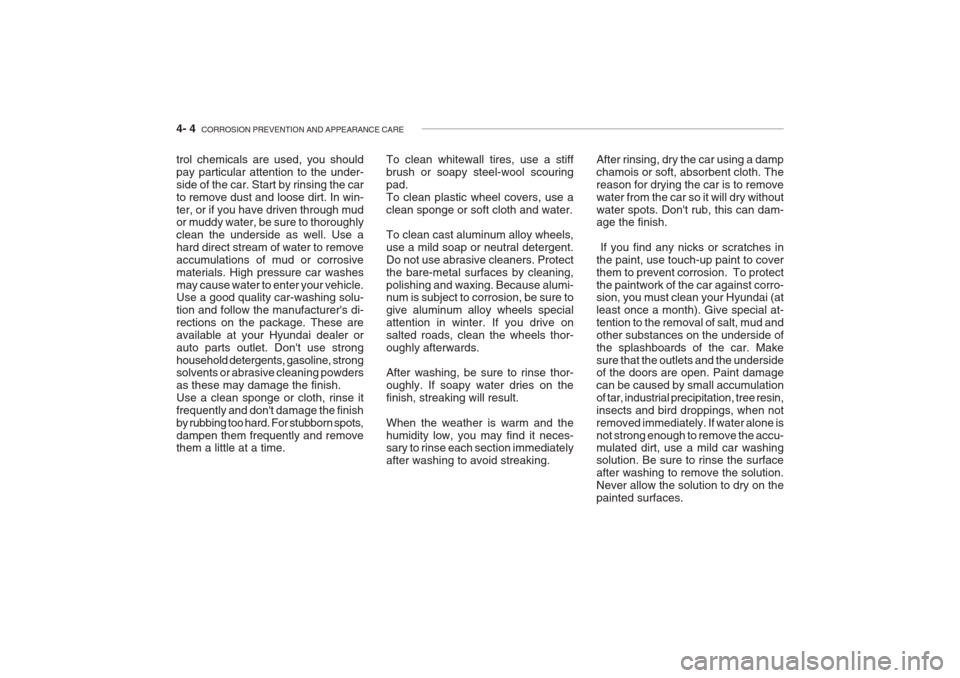
4- 4 CORROSION PREVENTION AND APPEARANCE CARE
trol chemicals are used, you should pay particular attention to the under-side of the car. Start by rinsing the carto remove dust and loose dirt. In win-ter, or if you have driven through mud or muddy water, be sure to thoroughly clean the underside as well. Use ahard direct stream of water to removeaccumulations of mud or corrosivematerials. High pressure car washesmay cause water to enter your vehicle. Use a good quality car-washing solu- tion and follow the manufacturer's di-rections on the package. These areavailable at your Hyundai dealer orauto parts outlet. Don't use stronghousehold detergents, gasoline, strong solvents or abrasive cleaning powders as these may damage the finish.Use a clean sponge or cloth, rinse itfrequently and don't damage the finishby rubbing too hard. For stubborn spots,dampen them frequently and remove them a little at a time. To clean whitewall tires, use a stiff brush or soapy steel-wool scouringpad.To clean plastic wheel covers, use aclean sponge or soft cloth and water. To clean cast aluminum alloy wheels, use a mild soap or neutral detergent.Do not use abrasive cleaners. Protectthe bare-metal surfaces by cleaning,polishing and waxing. Because alumi- num is subject to corrosion, be sure to give aluminum alloy wheels specialattention in winter. If you drive onsalted roads, clean the wheels thor-oughly afterwards. After washing, be sure to rinse thor- oughly. If soapy water dries on thefinish, streaking will result. When the weather is warm and the humidity low, you may find it neces- sary to rinse each section immediately after washing to avoid streaking. After rinsing, dry the car using a dampchamois or soft, absorbent cloth. Thereason for drying the car is to removewater from the car so it will dry withoutwater spots. Don't rub, this can dam- age the finish. If you find any nicks or scratches in the paint, use touch-up paint to coverthem to prevent corrosion. To protectthe paintwork of the car against corro- sion, you must clean your Hyundai (at least once a month). Give special at-tention to the removal of salt, mud andother substances on the underside ofthe splashboards of the car. Makesure that the outlets and the underside of the doors are open. Paint damage can be caused by small accumulationof tar, industrial precipitation, tree resin,insects and bird droppings, when notremoved immediately. If water alone isnot strong enough to remove the accu- mulated dirt, use a mild car washing solution. Be sure to rinse the surfaceafter washing to remove the solution.Never allow the solution to dry on thepainted surfaces.
Page 167 of 230
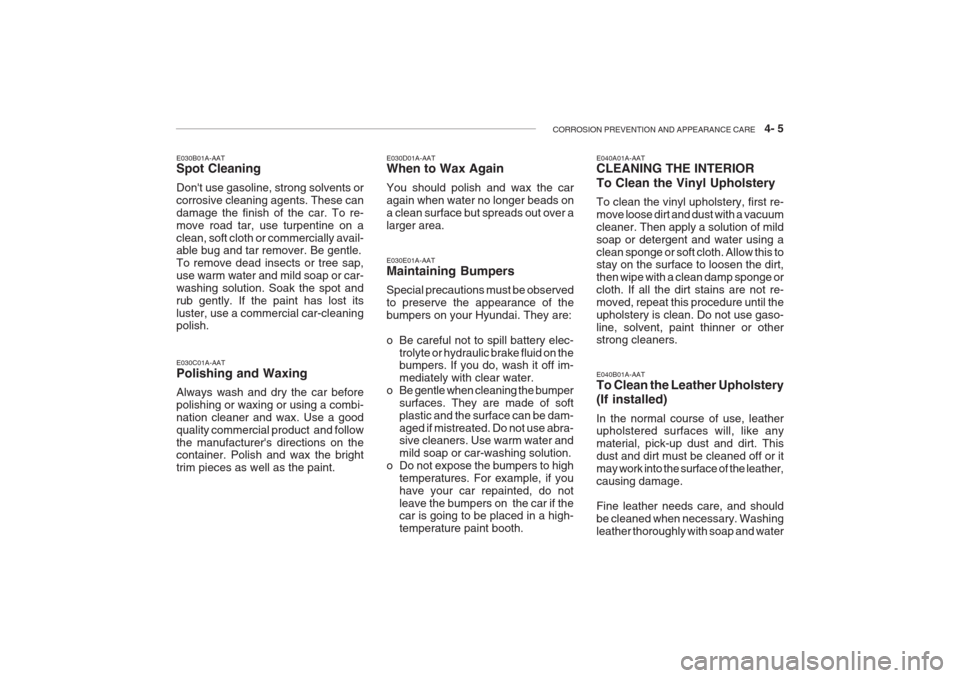
CORROSION PREVENTION AND APPEARANCE CARE 4- 5
E030D01A-AAT When to Wax Again You should polish and wax the car again when water no longer beads ona clean surface but spreads out over alarger area. E030E01A-AAT Maintaining Bumpers Special precautions must be observed to preserve the appearance of thebumpers on your Hyundai. They are:
o Be careful not to spill battery elec-
trolyte or hydraulic brake fluid on the bumpers. If you do, wash it off im- mediately with clear water.
o Be gentle when cleaning the bumper
surfaces. They are made of softplastic and the surface can be dam-aged if mistreated. Do not use abra- sive cleaners. Use warm water and mild soap or car-washing solution.
o Do not expose the bumpers to high
temperatures. For example, if youhave your car repainted, do notleave the bumpers on the car if the car is going to be placed in a high- temperature paint booth. E040A01A-AAT CLEANING THE INTERIOR To Clean the Vinyl Upholstery To clean the vinyl upholstery, first re- move loose dirt and dust with a vacuumcleaner. Then apply a solution of mildsoap or detergent and water using aclean sponge or soft cloth. Allow this to stay on the surface to loosen the dirt, then wipe with a clean damp sponge orcloth. If all the dirt stains are not re-moved, repeat this procedure until theupholstery is clean. Do not use gaso-line, solvent, paint thinner or other strong cleaners.
E030B01A-AAT Spot Cleaning Don't use gasoline, strong solvents or corrosive cleaning agents. These candamage the finish of the car. To re-move road tar, use turpentine on aclean, soft cloth or commercially avail- able bug and tar remover. Be gentle. To remove dead insects or tree sap,use warm water and mild soap or car-washing solution. Soak the spot andrub gently. If the paint has lost itsluster, use a commercial car-cleaning polish. E030C01A-AAT Polishing and Waxing Always wash and dry the car before polishing or waxing or using a combi-nation cleaner and wax. Use a goodquality commercial product and followthe manufacturer's directions on the container. Polish and wax the bright trim pieces as well as the paint.
E040B01A-AAT To Clean the Leather Upholstery (If installed) In the normal course of use, leather upholstered surfaces will, like any material, pick-up dust and dirt. Thisdust and dirt must be cleaned off or itmay work into the surface of the leather,causing damage. Fine leather needs care, and should be cleaned when necessary. Washingleather thoroughly with soap and water
Page 168 of 230
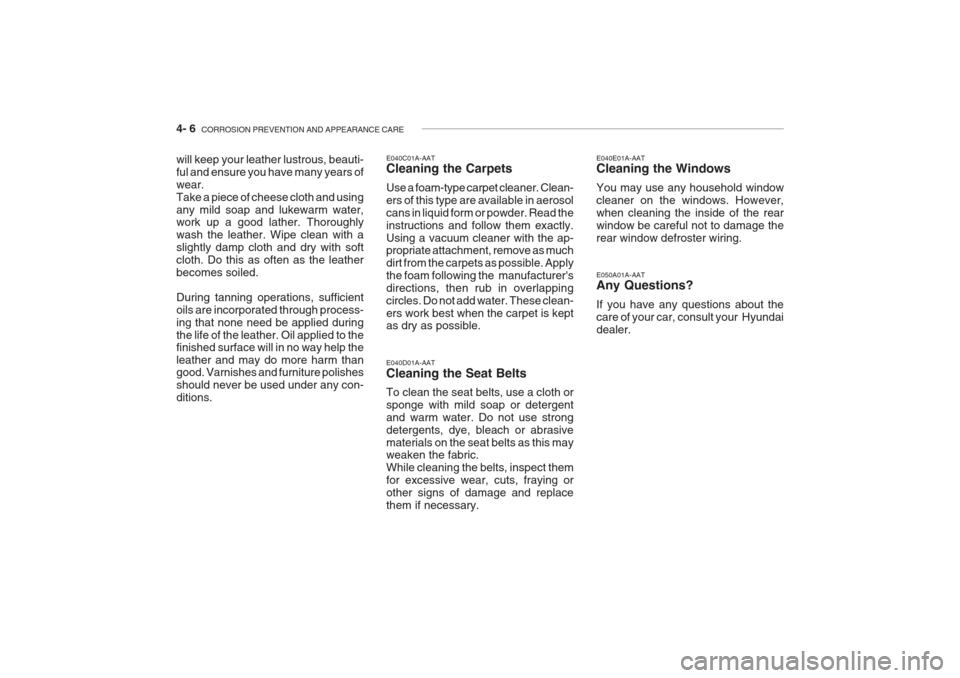
4- 6 CORROSION PREVENTION AND APPEARANCE CARE
E040E01A-AAT Cleaning the Windows You may use any household window cleaner on the windows. However,when cleaning the inside of the rearwindow be careful not to damage therear window defroster wiring. E050A01A-AAT Any Questions? If you have any questions about the care of your car, consult your Hyundaidealer.
E040D01A-AAT Cleaning the Seat Belts To clean the seat belts, use a cloth or sponge with mild soap or detergentand warm water. Do not use strongdetergents, dye, bleach or abrasivematerials on the seat belts as this may weaken the fabric. While cleaning the belts, inspect themfor excessive wear, cuts, fraying orother signs of damage and replacethem if necessary.
E040C01A-AAT Cleaning the Carpets Use a foam-type carpet cleaner. Clean- ers of this type are available in aerosolcans in liquid form or powder. Read theinstructions and follow them exactly.Using a vacuum cleaner with the ap- propriate attachment, remove as much dirt from the carpets as possible. Applythe foam following the manufacturer'sdirections, then rub in overlappingcircles. Do not add water. These clean-ers work best when the carpet is kept as dry as possible.
will keep your leather lustrous, beauti- ful and ensure you have many years ofwear.Take a piece of cheese cloth and usingany mild soap and lukewarm water, work up a good lather. Thoroughly wash the leather. Wipe clean with aslightly damp cloth and dry with softcloth. Do this as often as the leatherbecomes soiled. During tanning operations, sufficient oils are incorporated through process-ing that none need be applied duringthe life of the leather. Oil applied to thefinished surface will in no way help theleather and may do more harm than good. Varnishes and furniture polishes should never be used under any con-ditions.
Page 169 of 230
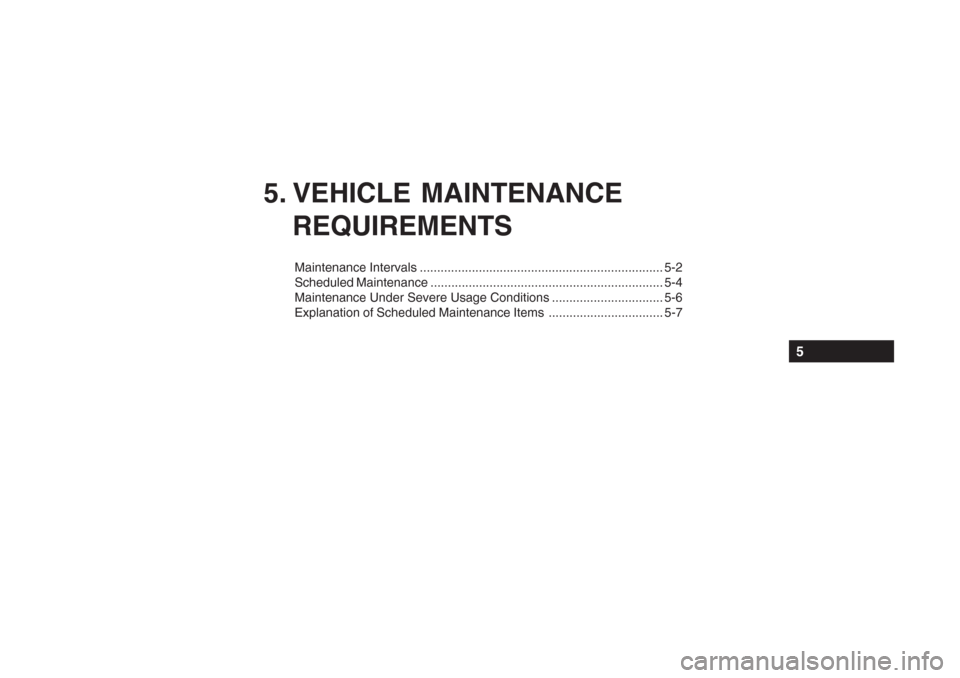
5. VEHICLE MAINTENANCEREQUIREMENTS
Maintenance Intervals ...................................................................... 5-2
Scheduled Maintenance ................................................................... 5-4
Maintenance Under Severe Usage Conditions ................................ 5-6
Explanation of Scheduled Maintenance Items ................................. 5-7
5
Page 170 of 230
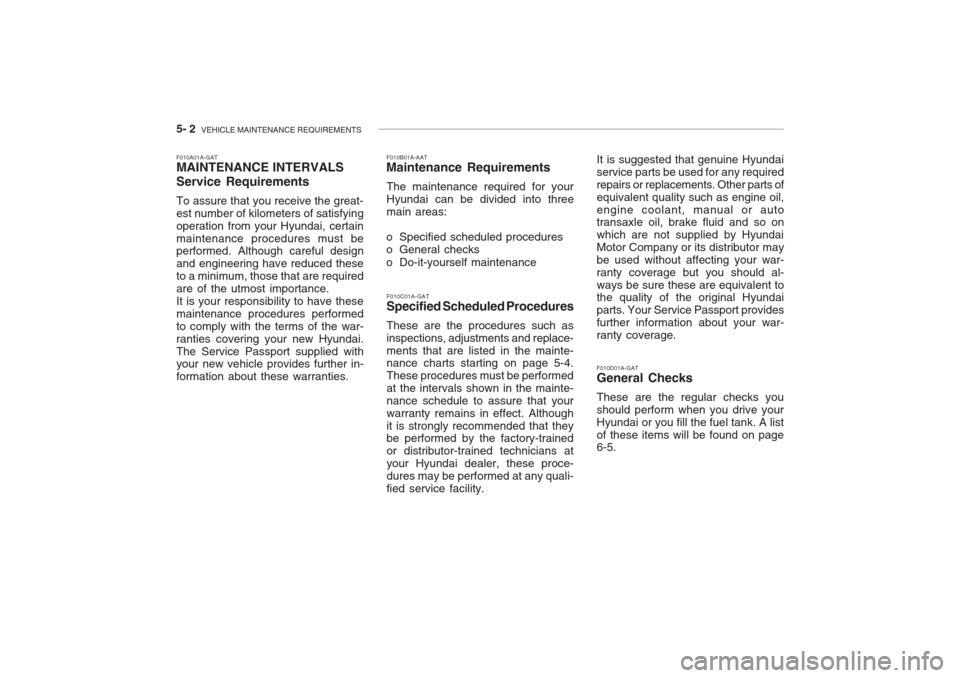
5- 2 VEHICLE MAINTENANCE REQUIREMENTS
F010C01A-GAT Specified Scheduled Procedures These are the procedures such as inspections, adjustments and replace-ments that are listed in the mainte- nance charts starting on page 5-4. These procedures must be performedat the intervals shown in the mainte-nance schedule to assure that yourwarranty remains in effect. Althoughit is strongly recommended that they be performed by the factory-trained or distributor-trained technicians atyour Hyundai dealer, these proce-dures may be performed at any quali-fied service facility. F010D01A-GAT General Checks These are the regular checks you should perform when you drive yourHyundai or you fill the fuel tank. A listof these items will be found on page 6-5.
F010A01A-GAT MAINTENANCE INTERVALS Service Requirements To assure that you receive the great- est number of kilometers of satisfyingoperation from your Hyundai, certainmaintenance procedures must be performed. Although careful design and engineering have reduced theseto a minimum, those that are requiredare of the utmost importance.It is your responsibility to have thesemaintenance procedures performedto comply with the terms of the war-ranties covering your new Hyundai.The Service Passport supplied with your new vehicle provides further in- formation about these warranties.
F010B01A-AAT
Maintenance Requirements
The maintenance required for yourHyundai can be divided into threemain areas:
o Specified scheduled procedures
o General checks
o Do-it-yourself maintenance It is suggested that genuine Hyundai service parts be used for any requiredrepairs or replacements. Other parts ofequivalent quality such as engine oil,engine coolant, manual or auto transaxle oil, brake fluid and so on
which are not supplied by HyundaiMotor Company or its distributor maybe used without affecting your war-ranty coverage but you should al-ways be sure these are equivalent to the quality of the original Hyundai parts. Your Service Passport providesfurther information about your war-ranty coverage.